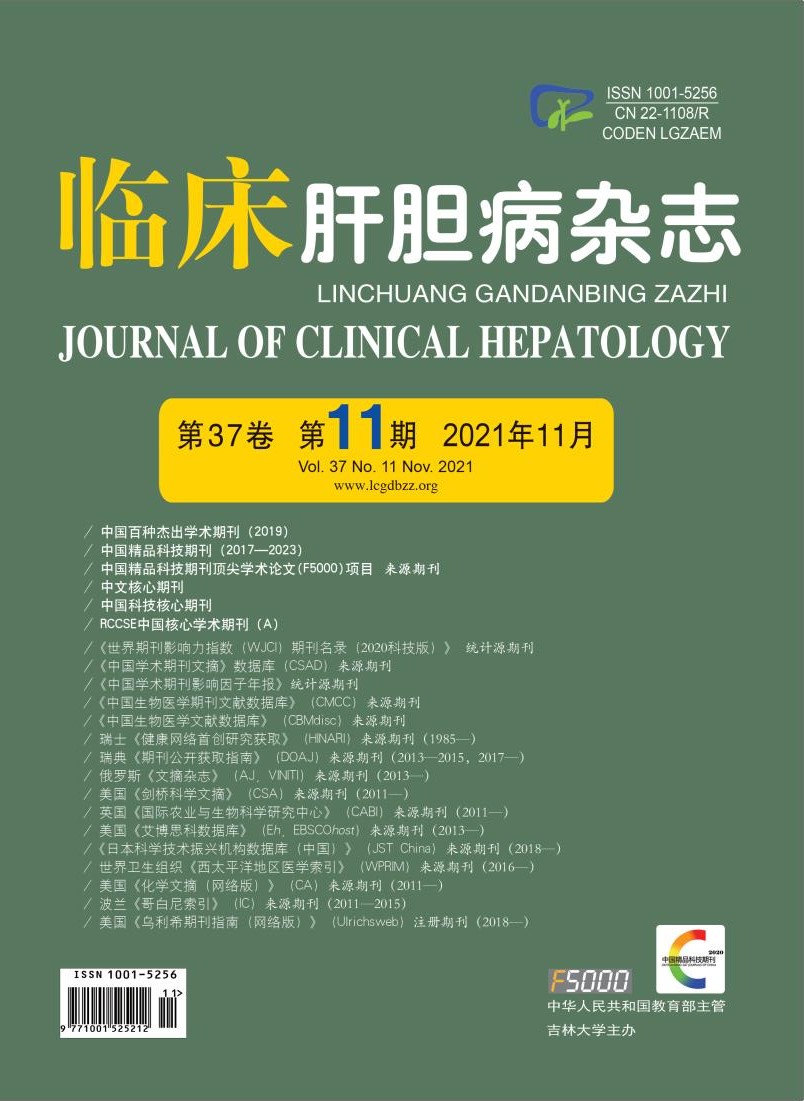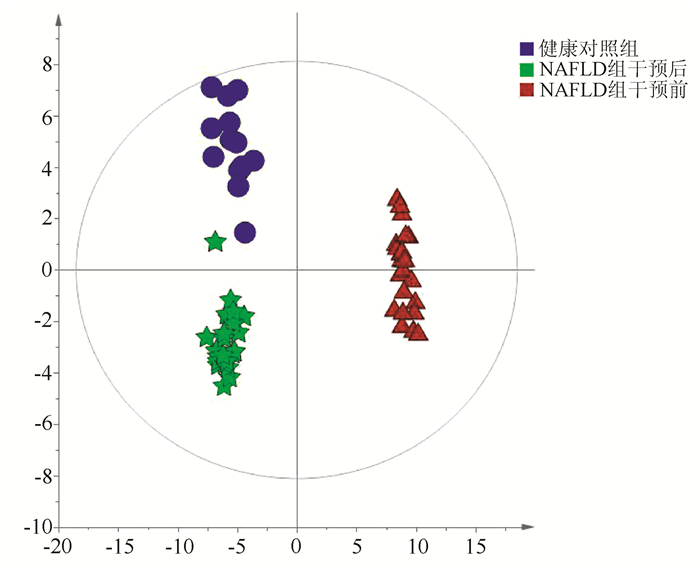| [1] |
DIEHL AM, DAY C. Cause, Pathogenesis, and Treatment of Nonalcoholic Steatohepatitis[J]. N Engl J Med, 2017, 377(21): 2063-2072. DOI: 10.1056/NEJMra1503519. |
| [2] |
GAO JJ, WANG T, JIANG YY, et al. Metabonomics and traditional Chinese medicine syndrome of nonalcoholic fatty liver disease[J]. J Clin Hepatol, 2020, 36(8): 1880-1882. DOI: 10.3969/j.issn.1001-5256.2020.08.044. |
| [3] |
ANGELICO F, DEL BEN M, CONTI R, et al. Non-alcoholic fatty liver syndrome: A hepatic consequence of common metabolic diseases[J]. J Gastroenterol Hepatol, 2003, 18(5): 588-594. DOI: 10.1046/j.1440-1746.2003.02958.x. |
| [4] |
YANG CQ, SHU L, WANG S, et al. Dietary patterns modulate the risk of non-alcoholic fatty liver disease in chinese adults[J]. Nutrients, 2015, 7(6): 4778-4791. DOI: 10.3390/nu7064778. |
| [5] |
BARSHOP NJ, SIRLIN CB, SCHWIMMER JB, et al. Review article: Epidemiology, pathogenesis and potential treatments of paediatric non-alcoholic fatty liver disease[J]. Aliment Pharmacol Ther, 2008, 28(1): 13-24. DOI: 10.1111/j.1365-2036.2008.03703.x. |
| [6] |
MARDINOGLU A, WU H, BJORNSON E, et al. An integrated understanding of the rapid metabolic benefits of a carbohydrate-restricted diet on hepatic steatosis in humans[J]. Cell Metab, 2018, 27(3): 559-571. e5. DOI: 10.1016/j.cmet.2018.01.005. |
| [7] |
JIMBA S, NAKAGAMI T, TAKAHASHI M, et al. Prevalence of non-alcoholic fatty liver disease and its association with impaired glucose metabolism in Japanese adults[J]. Diabet Med, 2005, 22(9): 1141-1145. DOI: 10.1111/j.1464-5491.2005.01582.x. |
| [8] |
FRIIS-LIBY I, ALDENBORG F, JERLSTAD P, et al. High prevalence of metabolic complications in patients with non-alcoholic fatty liver disease[J]. Scand J Gastroenterol, 2004, 39(9): 864-869. DOI: 10.1080/00365520410006431. |
| [9] |
HUANG W, KONG D. The intestinal microbiota as a therapeutic target in the treatment of NAFLD and ALD[J]. Biomed Pharmacother, 2021, 135: 111235. DOI: 10.1016/j.biopha.2021.111235. |
| [10] |
|
| [11] |
LIN L, YAN H, CHEN J, et al. Application of metabolomics in viral pneumonia treatment with traditional Chinese medicine[J]. Chin Med, 2019, 14: 8. DOI: 10.1186/s13020-019-0229-x. |
| [12] |
|
| [13] |
NASCIMBENI F, PAIS R, BELLENTANI S, et al. From NAFLD in clinical practice to answers from guidelines[J]. J Hepatol, 2013, 59(4): 859-871. DOI: 10.1016/j.jhep.2013.05.044. |
| [14] |
ZHANG HJ, HE J, PAN LL, et al. Effects of moderate and vigorous exercise on nonalcoholic fatty liver disease: A randomized clinical trial[J]. JAMA Intern Med, 2016, 176(8): 1074-1082. DOI: 10.1001/jamainternmed.2016.3202. |
| [15] |
VUPPALANCHI R, CHALASANI N. Nonalcoholic fatty liver disease and nonalcoholic steatohepatitis: Selected practical issues in their evaluation and management[J]. Hepatology, 2009, 49(1): 306-317. DOI: 10.1002/hep.22603. |
| [16] |
|
| [17] |
TIAN G, LI C, ZHAI YY, et al. Effect of Pudilan Xiaoyan Oral Liquid on energy metabolism in mice with acute pneumonia induced by LPS based on serum tar-geted metabolomics[J]. J Nangjing Univ Tradit Chin Med, 2021, 37(1): 120-125. DOI: 10.14148/j.issn.1672-0482.2021.0120. |
| [18] |
MA R, XIE Q, WANG J, et al. Metabolomics study on effects of compatibility of alcohol extracts of Magnolia officinalis and Polygala tenuifolia on urine metabolites in rats[J]. Chin Pharmacol Bull, 2019, 35(6): 870-877. DOI: 10.3969/j.issn.1001-1978.2019.06.026. |
| [19] |
WANG X, WANG X, XIE G, et al. Urinary metabolite variation is associated with pathological progression of the post-hepatitis B cirrhosis patients[J]. J Proteome Res, 2012, 11(7): 3838-3847. DOI: 10.1021/pr300337s. |
| [20] |
YU Y. The toxic effect of high dose phenylalanine on mice liver[D]. Changchun: Jilin University, 2018.
于杨. 高苯丙氨酸对小鼠肝脏的毒性作用[D]. 长春: 吉林大学, 2018.
|
| [21] |
SUN YX. Explore the protective mechanism of metformin on bisphenol A-induced liver injury in rats based on metabolomics[D]. Zhengzhou: Zhengzhou University, 2020.
孙亚新. 基于代谢组学技术的二甲双脈对双酚A诱导大鼠肝损伤的保护作用机制研究[D]. 郑州: 郑州大学, 2020.
|
| [22] |
WANG W, YANG J, QI W, et al. Lipidomic profiling of high-fat diet-induced obesity in mice: Importance of cytochrome P450-derived fatty acid epoxides[J]. Obesity (Silver Spring), 2017, 25(1): 132-140. DOI: 10.1002/oby.21692. |
| [23] |
WATERS PJ, PARNIAK M, AKERMAN BR, et al. Characterization of phenylketonuria missense substitutions, distant from the phenylalanine hydroxylase active site, illustrates a paradigm for mechanism and potential modulation of phenotype[J]. Mol Genet Metab, 2000, 69(2): 101-110. DOI: 10.1006/mgme.2000.2965. |








 DownLoad:
DownLoad:


